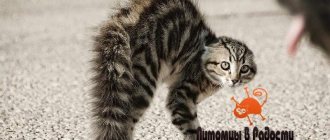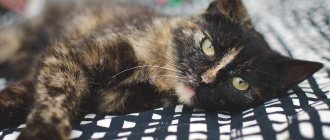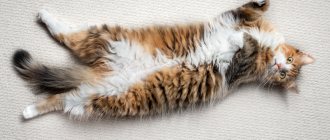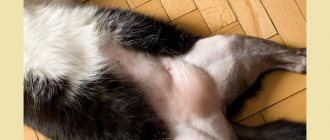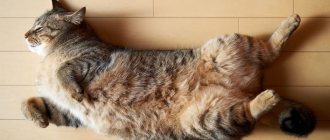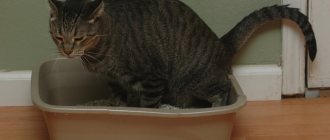If a cat's hind legs fail, this may indicate a traumatic injury, fibrocartilaginous embolism, stroke, spinal hernia, hyperparathyroidism, spinal cord inflammation, thromboembolism, a consequence of a tick bite, vitamin deficiency and metabolic disorders, hip dysplasia, cardiomyopathy. To find out the reason why the paws are failing, the owner should take the cat to the veterinarian. The doctor will diagnose and prescribe treatment.
According to veterinarian statistics, in 21% of cases, arterial thromboembolism with failure of the animal’s hind legs develops against the background of cardiomyopathy.
Reasons why a cat's legs can't walk
Back injury
Spinal injury and pinched nerves occur as a result of a fall from a height, a blow to the back and hind limbs with a heavy object, or a car injury. Most often, the vertebrae of the sacrolumbar region, where the sciatic nerve is located, are damaged. As a result of mechanical action, the bones are displaced and swelling occurs. In addition to the fact that the cat’s hind legs give way and are taken away, the following signs are observed:
- severe pain, especially if the animal moves;
- decreased or absent sensitivity and reflexes of the legs;
- anxiety;
- tachycardia;
- gait disturbance, the cat staggers and drags its paws.
Fibrous cartilaginous embolism
Fibrous cartilaginous embolism develops due to impaired blood supply to the spinal cord structures.
It is rare in cats and is characterized by closure of the spinal cord. Partial or complete cessation of blood supply to the spinal structures leads to cell dysfunction. The etiology of the disease is not clear. Fibrous-cartilaginous embolism begins acutely and suddenly, but the cat does not experience severe pain. The disease causes slight lameness or severe weakness of the hind legs, when the animal cannot stand up. Often the cat does not feel pain in the affected toes. The disease is characterized by uneven changes in the paws: the right side of the body may function worse than the left, and vice versa.
Consequence of stroke
The disease develops as a result of rupture of a vessel or blockage of the lumen by a thrombus. Because of this, the blood supply to the tissues is sharply disrupted and hypoxia occurs. The reason is stress, poisoning of various etiologies, hypertension, cardiovascular and kidney diseases, endocrine disorders, helminthiasis. Symptoms:
- their legs become weak, they don’t listen well, and their legs get twisted;
- coordination is impaired;
- unnatural head tilt;
- inappropriate behavior;
- decreased vision and appetite;
- uncontrolled urination and defecation;
- nystagmus;
- momentary fainting.
Herniated disc
Intervertebral hernia is accompanied by acute back pain and decreased sensitivity of the limbs.
If a cat's hind legs fail, this is a sign of protrusion of the vertebral nucleus and rupture of the fibrous ring. It develops in an old animal, as well as due to injuries, heavy physical exertion, or careless handling of the pet during play. Manifestation:
- severe back pain;
- the legs are very weak, they do not hold, they drag;
- the sensitivity of the hind limbs decreases.
Hyperparathyroidism
If a kitten's hind legs move apart, it cannot walk, drags its legs, collapses and falls, this indicates excessive production of parathyroid hormone by the thyroid gland. The cause is an imbalance of calcium and phosphorus due to improper diet. Paresis and deformation of the legs, impaired urination and defecation, growth retardation, and late change of teeth occur.
Spinal cord inflammation
Limb failure occurs due to spinal damage due to infectious diseases, poisoning, and traumatic back injuries. A pregnant cat that has purulent processes in the uterus can suffer. Signs:
- severe pain syndrome;
- hyperthermia;
- paralysis of the hind legs;
- hyperexcitability;
- licking and biting the back of the body.
Arterial thromboembolism
The formation of a blood clot triggers oxygen starvation, causing the animal to feel severe weakness in the legs.
When a cat stretches its hind legs, does not get up and falls, this indicates a blockage of the arteries with a blood clot. Impaired blood flow leads to oxygen starvation of tissues, which causes the cat's legs to hurt and collapse. The pathology occurs against the background of blood clotting disorders, neoplasms, decreased permeability of vascular walls, heart disease, and poisoning. Signs:
- changes in gait and the appearance of lameness;
- legs are cold and pale;
- severe muscle tension and soreness.
Tick bite
If one leg does not walk, the animal often squats, or the cat is paralyzed, this is a manifestation of an ixodid tick bite and the development of tick-borne encephalitis. In addition to the fact that the front or rear legs do not move, the disease is manifested by refusal of food, difficulty breathing, pallor of the mucous membranes, apathy, convulsions, changes in behavior and loss of coordination of movements.
Vitamin deficiency and potassium metabolism disorders
If a cat crouches and drags its hind paw when walking, this is a manifestation of a lack of vitamins B and D, which are necessary to strengthen bones, nerves, and muscle tissue. Potassium is needed for the transmission of nerve impulses, improving the functioning of the heart and kidneys. Veterinarians associate the etiology of vitamin deficiency and potassium deficiency with poor nutrition when the cat is malnourished or has helminths.
Hip dysplasia
The congenital disease leads to curvature of the pelvis, and in old age cats experience muscle weakness.
It is considered a congenital feline disease in which kittens are born with underdeveloped hip joints. In cats, due to weak ligaments, the paw does not function well, it drifts to the side when moving, and later paralysis, curvature of the pelvis, arthrosis of the hip joint, and habitual dislocation develop. An old cat develops muscle weakness, she is unable to lift her legs, drags them, and refuses to jump.
Cardiomyopathy
It is characterized by thickening of the walls and muscles of the heart, as a result of which the blood supply to all organs deteriorates. Often, against the background of cardiomyopathy, blood clots form that clog the blood vessels. Thromboembolism develops, due to which the hind limbs suffer and the cat falls on its hind paw.
Signs of limb failure
You can notice a cut or paralysis of the limbs in your pet based on various obvious signs. The most striking thing is that the pet slightly pulls one or both paws behind it, and the gait also becomes not as confident as that of a healthy animal, and painful sensations arise when leaning on the paws. It is very important to take a close look at your pet's behavior. The main signs of paralysis include the following:
- The gait becomes very unsteady, affecting mainly the back of the body.
- The animal is not able to maintain normal balance, and performs all movements somewhat slowly.
- There is a slight weakness in the cat's hind legs, which later develops into complete muscle failure.
- The animal can very often sit on the back. Most often, this behavior can be observed in old animals.
- The cat moves by dragging its paws behind it and without lifting them off the floor.
- In general, the animal’s mobility is noticeably reduced.
All of the above reasons are a warning sign that the animal may have problems with the musculoskeletal system. Delay in treatment or self-medication can lead to very serious consequences, so it is very important to consult a specialist in a timely manner.
What to do if a cat loses its paws?
Therapy is prescribed by a veterinarian individually. For injuries and thromboembolism, surgical intervention is performed. Symptomatic treatment and antibiotics alleviate the condition of a stroke or after a tick bite. In case of a herniated spine, the protrusion is removed and the displaced structures are put in place. You should massage the cat's hind legs - stroking, flexing and extending the legs, kneading. Hyperparathyroidism is treated with calcium supplements, and for vitamin deficiency, a balanced diet is prescribed.
Lameness with stomach pain
A common cause of lameness is stomach pain. Prolonged constipation, inflammation of the gastric mucosa or intestinal obstruction are all dangerous pathologies that require an urgent visit to the veterinarian.
With constipation and intestinal obstruction, hard feces can cause short-term paresis and paralysis. If a cat behaves lethargically, refuses food and water, drags its paws, or does not want to move at all, the only thing a loving owner can do is take the animal to the clinic. It is strictly forbidden to force feed your pet or try to give the cat any medications to normalize digestion.
We recommend the article: Why is there squelching in a cat’s ear?
Prevention of lameness
To prevent lameness, proper, balanced feeding of kittens is necessary (with industrial kitten food, or a homemade diet compiled together with a veterinary nutritionist), hygiene in breeding breeds prone to hereditary pathologies (Maine Coons, Scots, etc.), and careful attention to the pet , clinical examination in order to notice the occurrence of a problem in the early stages.
The cat is limping on its hind legs - video with a veterinary rehabilitologist about possible causes:
(c) Veterinary center for the treatment and rehabilitation of animals “Zoostatus”. Varshavskoe highway, 125 building 1. tel.
8 (499) 372-27-37
Hind limb injuries
Very often, cats get into car accidents, the consequence of such injuries can be a pelvic fracture. In such cases, it is almost impossible to restore the cat’s health at home. The animal must be anesthetized and anti-shock therapy administered by infusion, and this can only be done in a clinic. Depending on the severity of the injury, your cat may need to undergo surgery to realign the injured limbs.
Treatment of arthritis and arthrosis
How to treat arthritis in a cat? The first and most important rule is do not self-medicate! Therapy of joint tissue diseases requires professionalism and experience, so entrust the treatment to qualified veterinarians in Moscow.
They will determine the cause of arthritis or arthrosis, and then select effective therapy aimed at eliminating it. Additionally, maintenance treatment is prescribed using chondroprotectors and non-steroidal anti-inflammatory drugs.
In addition to drug therapy, it is important to monitor your pet’s weight. If your cat is obese, be sure to put him on a low-calorie diet. This may include:
- lean meat,
- sea fish,
- low-fat fermented milk products,
- porridge on the water,
- boiled vegetables.
Don't forget about regular checkups at the veterinary clinic!
Symptoms of joint damage
The first thing you will notice when a cat develops arthritis or arthrosis is behavioral changes. If before the pet loved to run, jump and play, now he takes care of his paw and avoids stress. At stages II and III of the disease, the animal experiences pain even when moving short distances (for example, from one room to another).
The main symptoms of arthritis and arthrosis in cats:
- Soreness . It is observed in the affected area, while the pet becomes angry if someone tries to touch it, and meows loudly;
- Stiffness . The animal loses motor activity and rests more often. Begins to walk slowly and limp;
- Edema . There is swelling in the problem area. The cat's body temperature rises, especially with severe pain;
- Crunch . Due to the destruction of the layer between the cartilages, strong friction of the bones occurs, so when the cat moves, a specific crunching sound (rough, dry clicking) may be observed.
Note! Arthritis and arthrosis negatively affect the appearance of the pet. Because of the pain, he practically stops caring for his fur: it becomes dirty and gets tangled.
